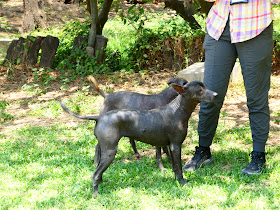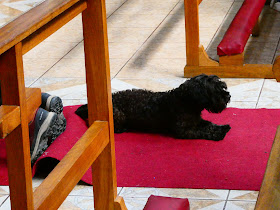There is quite a different situation regarding dogs and cats in Peru and I suspect in most Central and South American countries. First of all, very few cats were to be seen on this trip, and I think that the few that we saw were feral. Maybe we didn’t see more of them because they were mostly out at night. I am a sucker for cats since I have one of my own. The kitten at the top of this post looks a lot like the cat I have at home. I wanted to scoop her up and take her back with me!
This one was huddled on the sidewalk outside out hotel in Chiclayo.
About half way through the trip, while still in the Northern coastal area, we ate lunch at an out of the way open air restaurant.Hanging around were a mother cat and 4 almost grown kittens. 2 calicos and 2 tabbies. The staff of the restaurant would shoo them away routinely. I do not know what they ate, but we took the opportunity to drop morsels of food down to them when no one was looking. They would eat anything, as opposed to cats in the Western world that can be quite picky. I even reached down to scratch the mother cat on her head, and she meowed at me in response.
Dogs were another matter altogether. They roamed the streets at will, but we were told that they were not strays, even though very few had collars. All of them looked well cared for, groomed and well fed. After one of the ladies I was walking around Aguas Calientes with gave a nice looking German shepherd a scratch on the head, he followed us back to our hotel, only to be chased away by the security guard. Most dogs however, did not welcome human contact or being touched. If you had food, that was probably another matter.
Here are dogs at the parking lot to Chan Chan. The one on the hill was clearly the top dog of the pack.
These hairless dogs were being kept and bred on the grounds of the National Museum of Sipan.
This chunky beagle was patrolling the village square in Pisac.It was not unusual to find a dog napping right on the sidewalk. One had to be careful not to step on them.This cutie was hanging out inside the local church in Aguas Calientes. So here is the scoop. Most people who own dogs let them out in the morning so that they can roam and play with their friends. They have quite a life of their own. It is assumed that they return home at night or when they are hungry. A lot of them hang around where their owner works—a shop or restaurant. In Cusco, we saw a few with coats on. In Lima, we were staying in the nicer part of town, and we saw numerous dog walkers out with multiple dogs each.
I remember years ago when we were camping out at Raqchi in Peru when the village dogs started to hang around. They all looked to be on the scrawny side. Then the top dog in charge arrived. He was medium size, well fed, black and had a spiked collar on. Clearly he was there to “boss” the rest of the dogs.
And of course
there are the guinea pigs. They are not
pets, but are eaten on special occasions.
Most households raise them. Here we were visiting a traditional household in Ollantaytambo.
Interesting that if you search the internet for guinea pig, you get the pet. If you search for cuy, the Quechua word for them, you get meat. I prefer neither!















No comments:
Post a Comment